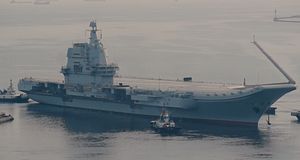The People’s Liberation Army Navy’s (PLAN) first domestically designed and built aircraft carrier, the Type 002 (CV-17), departed the Dalian Shipbuilding Industry Company (DSIC) shipyard in China’s Liaoning Province for a second round of sea trials on August 26.
Images and videos published by Chinese media shows the yet-to-be christened aircraft carrier, previously designated Type 001A and expected to be named Shandong, with an empty flight deck leaving port accompanied by several tug boats. The second round of sea trials is reportedly slated to test the carrier’s communication and navigation systems, next to testing the flattop’s modified propulsion system.
Initial sea trials took place in May 2018 in the northeastern part of the Bohai Sea, the innermost gulf of the Yellow Sea and Korea Bay, and primarily tested the reliability of the warship’s power and propulsion systems. The carrier is expected to remain at sea for several days. Several more sea trials are planned before the flattop’s commissioning into service by the PLAN, speculated to take place in 2020. (There is also speculation that the commissioning date might be moved up by a year.)
Sea trials of China’s new carrier are expected to take between six to 12 months. As I wrote earlier this year, the PLAN’s first domestically built flattop is a derivative of Soviet Navy carrier designs:
The 65,ooo-ton Type [002] carrier was launched at the DSIC shipyard in April 2017. The warship is an improved variant of the PLAN’s only operational aircraft carrier, the 60,000-ton Type 001 Liaoning — a retrofitted Soviet-era Admiral Kuznetsov-class multi-role aircraft carrier. (…)
The [yet-to-be-named carrier] has been fitted with a so-called ski-jump assisted Short Take-Off But Arrested Recovery (STOBAR) launch system also installed aboard the Liaoning. STOBAR-launched aircraft have a more limited operational range and carry lighter payloads than fighter jets launched from so-called Catapult-Assisted Take-Off But Arrested Recovery (CATOBAR) systems used on U.S. Navy carriers. (STOBAR systems put a lot of strain on the airframe of fighter jets during take-off.)
The [future] Shandong will be able to carry up to 24 Shenyang J-15 multirole fighter jets and a variant of the fourth-generation Sukhoi Su-33 twin-engines air superiority fighter, as well as around ten rotary wing aircraft including Changshe Z-18, Ka-31, or Harbin Z-9 helicopters.
Once commissioned, the carrier will likely serve in the the PLAN’s North Sea Fleet or East Sea Fleet.
China reportedly began construction of a third aircraft carrier, purportedly designated Type 003, at a Shanghai shipyard last year. The new conventionally-powered carrier is expected to be fitted with a (CATOBAR) aircraft launch system.
































